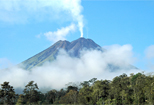-
Hotels
-
By Location
- - Arenal Volcano (La Fortuna)
- - Monteverde
- - Papagayo Gulf
- - Flamingo / Tamarindo
- - Guanacaste, Liberia
- - San Jose City
- - Near International Airport
- - Cahuita & Puerto Viejo
- - Tortuguero
- - Manuel Antonio
- - Jaco Beach
- Other Locations...
Northern RegionNorth Pacific RegionCentral ValleyCaribbean CoastCentral Pacific - Category
- Budget
- Main Cities
-
By Location
- Vacations and Activities
- Where to Go
- Transportation
- Costa Rica Info
-
Maps
The National Park

The Arenal Volcano National Park presents varied topographic systems such as mountain ranges, passes, mountain channels and depressions that mostly have developed from volcanic ash. In this part at least three types of soils have been identified. Additionally, soils of the low zones, with an abundance of dense thickets and pastures are to be found.
The Arenal Volcano National Park belongs to the Arenal Conservation Area that consists of three life zones: premontane humid forest, premontane rainforest and lower montane rain forest. The combination of these life zones makes the moist and wet evergreen spectacular. In these zones you can find 2,987 species of plants, including at least 20 species of medicinal plants, 884 ornamental ones, 90 species of timber trees, 63 edible species, at least 15 toxic ones, 17 of great importance for the wildlife and more than 100 species classified as undergrowth and grow lands.
The National Park is part of a biologic corridor between the Caribbean and Pacific sectors. The combination of forests and life zones provide habitat for many different animals, including endangered ones which make this an unique place. More than 15 species of amphibians have been identified, including the green and black frog (Atelopus Varius) and the glass frog. There are also different species of snakes, as well poisonous, like the Fer-De-Lance, as non-poisonous, like the Boa Constrictor.
The park is a place where it is still possible to see great curassows, great anteaters, jaguarondis, pacas, tapirs, coatis, sloth, jaguars, deer and pumas. Large groups of howler monkeys, kinkajous, and margays are also present. At least 200 species of birds can be found, such as crimson-fronted parakeet, the white-bellied mountain-gem and the black-faced solitaire.
 Arenal at a glance Arenal at a glance
|
(506) 2257-4171
Toll Free: 1-877-281-8515
Costa Rica: (506) 2233-5151
Fax: (506) 2233-5284
E-mail: [email protected]
Costa Rica Hotels | Costa Rica Vacation Packages | Costa Rica Tours | Car Rental
Terms & Conditions | Privacy Terms | Contact Us | About Us | Comments & Reviews
The Costa Rica vacations planning site with information about accommodations, tours, transportation, maps of Costa Rica, main cities and travel tips.


